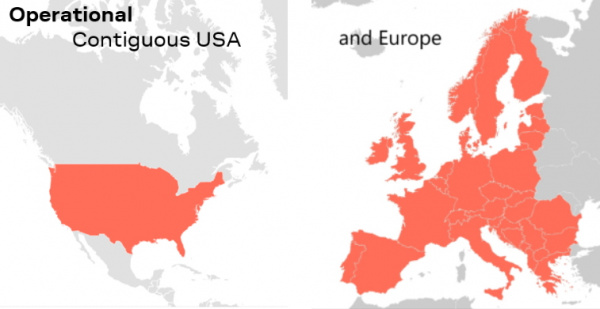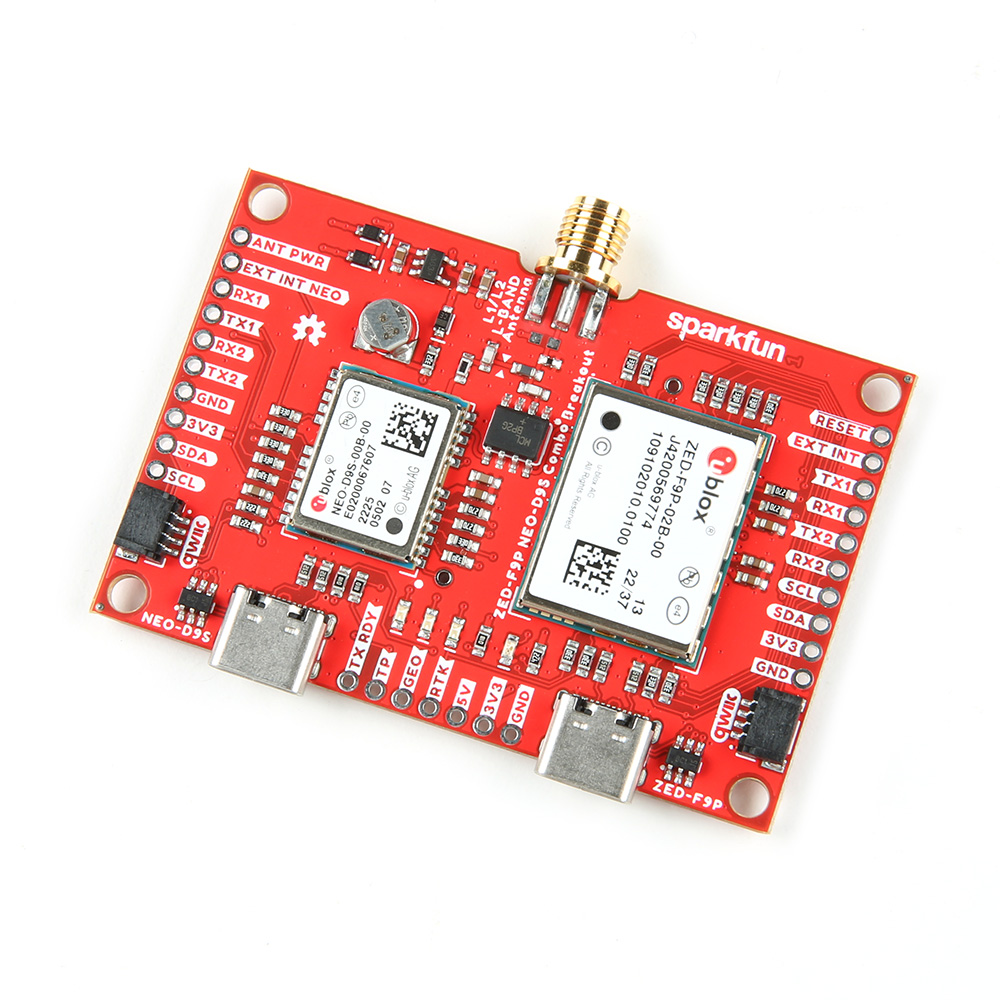SparkFun GNSS Combo Breakout - ZED-F9P, NEO-D9S (Qwiic)
With GNSS, you can know where you are, where you're going, and how to get there anywhere on Earth within 30 seconds. This means the higher the accuracy, the better! Our versatile global positioning combo breakout pairs the u-blox ZED-F9P multi-band high-precision GNSS module with the NEO-D9S L-band GNSS correction data receiver. With a clear view of the sky, specifically to the South, this combo breakout will deliver centimeter-level accuracy positioning without needing separate RTK or NTRIP corrections!
The ZED-F9P and NEO-D9S combo board raises the bar for high-precision GPS and is one of a line of mighty SparkFun RTK boards. The ZED-F9P is a top-of-the-line module for high-accuracy GNSS and GPS location solutions capable of centimeter-level three-dimensional accuracy. With this board, you will know where your (or any object's) X, Y, and Z location is better than an inch without needing a separate correction source!
We've paired the ZED-F9P with the NEO-D9S-00B satellite data receiver for the L-band correction broadcast. The NEO-D9S can be configured with various L-band correction services, including u-blox's PointPerfect service. It decodes the satellite transmission and outputs a correction stream directly to the ZED-F9P via UART2, enabling the ZED-F9P to reach accuracies down to the centimeter level straight out of the box!
The combo breakout features two USB-C connectors, one for the ZED-F9P and one for the NEO-D9S. With these two connectors, you can hook up the board to your laptop and configure both devices using u-blox u-center if you want to. We've also equipped the board with two Qwiic connectors, so you can connect it quickly and easily to your favorite development board and control it using our sophisticated u-blox GNSS Arduino Library. The ZED-F9P and NEO-D9S share a single SMA antenna connection thanks to a miniature surface-mount power divider (antenna splitter), and 3.3V power is provided for an active antenna. If that wasn't enough, we've provided breakout pads for both devices' I2C, UART1, and UART2 ports on both devices. The UART2 pins are inter-connected (crossed-over) by default so that the NEO-D9S can feed corrections directly to the ZED-F9P, but you can isolate them if you want to by opening the jumper links.
Please Note: PointPerfect L-Band correction service for the SparkFun GNSS Combo Breakout - ZED-F9P, NEO-D9S is currently only
available in the USA's 48 contiguous states and the European Union shown in the coverage map below. More information on PointPerfect can be found here.

Accessories Required: This product requires a suitable L-Band antenna. The ANN-MB-00 GNSS Multiband Antenna (GPS-15192) won't work with Europe's PointPerfect L-Band correction service.
Choose a compatible antenna from our Hookup Accessories section below for L-Band correction in Europe. We've carefully selected accessories that work seamlessly with this service.

Accessories Required: This product requires a suitable L-Band antenna. The ANN-MB-00 GNSS Multiband Antenna (GPS-15192) won't work with Europe's PointPerfect L-Band correction service.
Choose a compatible antenna from our Hookup Accessories section below for L-Band correction in Europe. We've carefully selected accessories that work seamlessly with this service.
The SparkFun Qwiic Connect System is an ecosystem of I2C sensors, actuators, shields and cables that make prototyping faster and less prone to error. All Qwiic-enabled boards use a common 1mm pitch, 4-pin JST connector. This reduces the amount of required PCB space, and polarized connections mean you can’t hook it up wrong.
ZED-F9P Features:
- Concurrent reception of GPS, GLONASS, Galileo and BeiDou
- Receives both L1C/A and L2C bands
- ZED-F9P Current Consumption: 68mA - 130mA (varies with constellations and tracking state)
- Time to First Fix: 25s (cold), 2s (hot)
- Max Navigation Rate:
- PVT (basic location over UBX binary protocol) - 25Hz
- RTK - 20Hz
- Raw - 25Hz
- Horizontal Position Accuracy:
- 2.5m without RTK
- 0.010m with RTK
- Operational Limits
- Max G: ≤4G
- Max Altitude: 50km (49.7 miles)
- Max Velocity: 500m/s (1118mph)
- 1.5mAh battery backup for RTC
- Default I2C address: 0x42
NEO-D9S Features:
- Concurrent reception with L-Band Satellite
- Receives L-Band
- 1525 MHz to 1559 MHz
- Time to First Frame
- <10s @ 2400bps
- User Data Rates
- 600, 1200, 2400, 4800 baud
- Vehicle Dynamics
- Dynamics: +/- 2g acceleration for all data rates (600 bit/s, 1200 bit/s, 2400 bit/s, 4800 bit/s)
- Velocity: Up to and including 300 km/h
- Current Consumption (Acquisition & Tracking):
- Peak: 130mA
- Average: 35mA
- Default I2C address: 0x43
Breakout Features:
- Input Voltage: 5V or 3.3V but all logic is 3.3V
- 2x USB Type C Connector
- Separate connectors for the ZED-F9P and NEO-D9S
- 2x Qwiic Connectors
- Integrated SMA connector for use with a L1/L2/L-Band antenna of your choice
- On-board power divider (antenna mux)
- 3.3V power for an active antenna
- LEDs
- Power
- RTK (Off: No Carrier Solution; Flashing: Floating Solution; On: Fixed Solution)
- GEO: Geofence
- TP: Timing Pulse (Pulse Per Second)
- Jumpers
- LEDs x 4
- UART2: TX2-RX2 RX2-TX2
- I2C Pull-Up Resistors
- USB Shield
- Board Dimensions
- 1.70" x 2.50" (43.2mm x 63.5mm)
Note: The I2C address of the ZED-F9P is 0x42. The I2C address of the NEO-D9S is 0x43. Both are software configurable. A multiplexer/Mux is required to communicate with multiple ZED-F9P modules on a single bus. If you need to use more than one ZED-F9P module, consider using the Qwiic Mux Breakout.
SparkFun Resources:
- Product Manual
- Schematic
- Eagle Files
- Board Dimensions
- Qwiic Info Page
- Building a GNSS System
- Arduino Library - v3
- GitHub Hardware Repo
u-blox Resources:
- NEO-D9S and ZED-F9 configuration - SPARTN L-band correction data reception
- u-blox u-center - GNSS evaluation software for Windows
- PointPerfect GNSS augmentation service
- PointPerfect Product Summary
- PointPerfect Service Description
- PointPerfect Service Coverage
- Thingstream IoT service delivery platform
- Thingstream Login
- Thingstream Registration
Comments
Looking for answers to technical questions?
We welcome your comments and suggestions below. However, if you are looking for solutions to technical questions please see our Technical Assistance page.
Customer Reviews
No reviews yet.





Hi everybody, I try to get a sparkfun combo board connected to the L band and doing it with Point Perfect. In the Arduino example collection I can find examples to pump the data with SPI and I2C, but not direct from NEO D9S to ZED-F9P through UART 2, which is the standard case of the combo board. I hope you can give me a hint. Best regards and thanks Bernhard
Will any L1/L2 antenna work, or does it need to be L1/L2/L5? For example, will your GPS-17751 or GPS-21801 work?
Good question. We've actually had a lot of success receiving corrections for the NEO-D9S with GPS-17751. Here's a relevant post in the forums asking the same exact question:
https://forum.sparkfun.com/viewtopic.php?f=116&t=60004&p=243010&hilit=antenna#p243010
Great - thanks!
I don't see a mention of a requirement for a base station. Are there other required components and external measurements for this setup, or is this finally an "all-in-one" high-resolution positioning solution? The product almost seems too good to be true if it offers high resolution without a base station at a comparably low price! I'm looking for a solution offering high outdoor measurement repeatability over absolute global positioning. Any thoughts or enhancements to add this information to the product description would be welcome!
The information that you're looking for is in the hookup guide. The short of it is, is that yes, this board has a capable GNSS receiver (ZED-F9P) that can output millimeter precision but requires correction data. The other module on the board, the NEO-D9S, is capable of receiving correction data and is setup for piping that data to the ZED-F9P ( and there are Arduino examples to do this in our library) but, and here's the relevant bit, requires a subscription to a correction data service. No base station needed, but you will need a subscription. Again, check out the hookup guide or visit our forums, forums.sparkfun.com. There are many posts on this topic and users that are willing to help if you don't find the answer you're looking for.
Perfect! That gave me exactly the info I was looking for but missed. I appreciate the help!
That's not the way GNSS works and based on the vocabulary of your comment you already know it. To get an absolute cm accuracy gnss result without a base station (whether your base station or a subscription service) sending corrections would be a major breakthrough and COULD NOT be offered for a few hundred dollars.